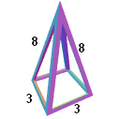Vertex figure


In geometry, a vertex figure represents the arrangement of a connected set of points of all the neighboring vertices, in a polytope to a given vertex. This applies equally well to infinite tilings, or space-filling tessellation with polytope cells.
A vertex figure for an n-polytope is an (n-1)-polytope. For example, a vertex figure for a polyhedron is a polygon figure, and the vertex figure for a polychoron is a polyhedron figure.
By considering the connectivity of these neighboring vertices, a full imaginary (n-1)-polytope can be constructed for each vertex of a polytope:
- Each vertex of the vertex figure coincides with a vertex of the original polytope.
- Each edge of the vertex figure exists on or inside of a face of the original polytope connecting two alternate vertices from an original face.
- Each face of the vertex figure exists on or inside a cell of the original n-polytope (for n>3).
- ...and so on to higher order elements in higher order polytopes.
Vertex figures are the most useful for uniform polytopes because one vertex figure can imply the entire polytope.
For polyhedra, the vertex figure can be represented by a vertex configuration notation, by listing the faces in sequence around a vertex. For example 3.4.4.4 is a vertex with one triangle and 3 squares, and it represents the rhombicuboctahedron.
If the polytope is vertex-uniform, the vertex figure will exist in a hyperplane surface of the n-space. In general the vertex figure need not be planar.
Also nonconvex polyhedra, the vertex figure may also be nonconvex. Uniform polytopes can have either star polygon faces and vertex figures for instance.
Regular polytopes
If a polytope is regular, it can be represented by a Schläfli symbol and both the cell and the vertex figure can be trivially extracted from this notation.
In general a regular polytope with Schläfli symbol {a,b,c,....,y,z} has cells as {a,b,c,...,y}, and vertex figures as {b,c,...,y,z}.
- For a regular polyhedron {p,q}, the vertex figure is {q}, a q-gon.
- Example, the vertex figure for a cube {4,3}, is the triangle {3}.
- For a regular polychoron or space-filling tessellation {p,q,r}, the vertex figure is {q,r}.
- Example, the vertex figure for a hypercube {4,3,3}, the vertex figure is a regular tetrahedron {3,3}.
- Also the vertex figure for a cubic honeycomb {4,3,4}, the vertex figure is a regular octahedron {3,4}.
Since the dual polytope of a regular polytope is also regular and represented by the Schläfli symbol indices reversed, it is easy to see the dual of the vertex figure is the cell of the dual polytope.
an example vertex figure of a honeycomb
The vertex figure of a truncated cubic honeycomb is a nonuniform square pyramid. One octahedron and four truncated cube meet at each vertex for form a space-filling tessellation.
| Vertex figure: A nonuniform square pyramid | 
|
| Created as a square base from an octahedron | 
|
| And four isosceles triangle sides from truncated cubes | 
|
Edge figures
In higher order polytopes other lower order figures can be useful. For instance an edge figure of a polychoron or 4-honetcomb is a polygon representing the set of faces around an edge. For example the edge figure for a regular cubic honeycomb {4,3,4} is a square, and for a regular polychoron {p,q,r} is the polygon {r}.
See also
External links
- Weisstein, Eric W. "Vertex figure". MathWorld.
- Olshevsky, George. "Vertex figure". Glossary for Hyperspace. Archived from the original on 4 February 2007.
- Consistent Vertex Descriptions
